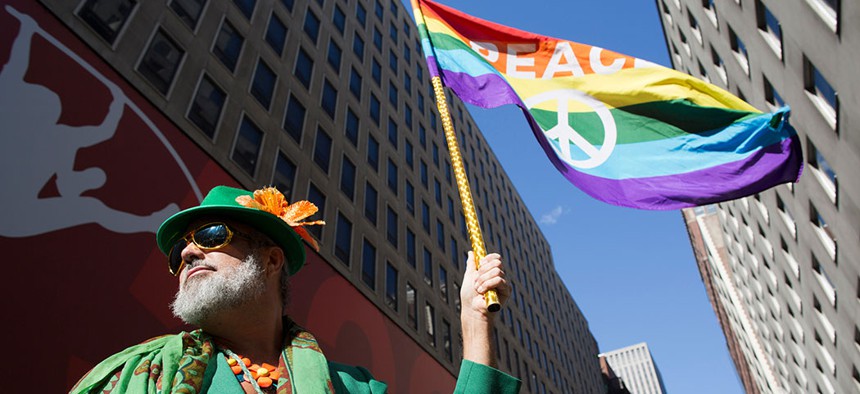New York City
St. Patrick’s Day parade controversy continues on Staten Island
Issues persist when it comes to St. Patrick’s Day parades around the city including gay, lesbian and transgender New Yorkers to walk in parades under their own banner.

Steven Menendez waves the Gay Pride flag as he waits for the St. Patrick's Day parade to begin in New York, 2016. Mary Altaffer/AP/Shutterstock
In 2016, New York City Mayor Bill de Blasio marched for the first time in Manhattan’s annual St. Patrick’s Day parade, which he had boycotted due to its ban on LGBT groups in the festivities. By the old rules, gay, lesbian and transgender New Yorkers could walk in the parade – just not under their own banner. When those rules changed, de Blasio resumed the traditional role of the mayor marching at or near the front of the parade.
But on Staten Island, those restrictions still apply. At the parade, held on March 3, some local politicians joined in the procession, but Republican Borough President James Oddo and Rep. Max Rose, a Democrat, chose not to attend.
“I won’t be marching in Sunday's St. Patrick's Day parade,” Oddo said on Twitter. “I wanted to, and thought I could reconcile my call for inclusion with still marching, but internally I cannot. No disrespect is intended towards anyone, including colleagues who will march.”
Rose similarly announced his decision not to attend, tweeting, “I struggled with how to support our LGBTQ community while still honoring our Island’s rich Irish heritage, but for me I cannot march while the @pridecenterSI is still excluded. Let’s all work towards making 2020 the parade Staten Island deserves.”
Last month, Carol Bullock, executive director of the Pride Center of Staten Island, an LGBT community center, told NY1 that her group’s application to march in the parade with a banner was denied for the second time. Bullock told NY1 that she was informed by Staten Island parade organizer Larry Cummings that the banner goes against the tenets of Catholicism by promoting a “homosexual lifestyle.” De Blasio declined to attend the Staten Island ceremony following the comments, with a spokesperson calling it “noninclusive.” Gov. Andrew Cuomo tweeted his support for the advocacy organization, saying: “New York is the State of love. I stand with the Pride Center of Staten Island. @pridecenterSI should be permitted to march in the Staten Island St Patrick’s Parade. (It’s way past time).”
The Staten Island parade is the last holdout against LGBTQ inclusion in the annual celebration of Irish heritage. Of New York’s 29 parades held for the holiday, the southernmost borough is the only location where LGBT participation is barred. However, outside of New York, cities like Boston faced similar boycotts by politicians for denying banner participation by LGBT groups.
The New York City St. Patrick’s Day parade has received calls many times over its 260-year history to update the festivities for the present, such as when Dorothy Hayden Cudahy became the first woman to marshal the parade in 1989, after four years of campaigning. In the early 1990s, LGBT groups started to lobby to march under a banner in the parade. Then-Mayor David Dinkins electing to march in 1991 with a gay Irish group, and was roundly booed.
Following this year’s Staten Island parade, Oddo said he hopes the organizers will change their approach next year.
“I believe the Staten Island Pride Center should be welcomed to march under its banner, and I said so,” Oddo told City & State in an email. “For me, the natural extension of expressing those sentiments publicly was to back it up with the act of not attending the parade. While I was heartened to see the outpouring of support for the LGBTQ community at this year’s event, we now have a year to correct this wrong, to end this needless angst, to unify as a community, and make the Staten Island St. Patrick’s Day Parade a joyously inclusive event in 2020 and beyond.”
Here’s a history of New York City’s evolving St. Paddy’s Day parades:
1989 – Dorothy Hayden Cudahy, a broadcaster, is the first female grand marshal of the New York City St. Patrick’s Day parade.
1991 – Members of New York’s Irish Lesbian and Gay Organization are allowed to march and are joined by Mayor David Dinkins, who walks with them instead of in the mayor’s traditional spot at the front of the parade.
1992 – Irish Lesbian and Gay Organization is banned from marching, and Dinkins and Gov. Mario Cuomo boycott the parade.
2000 – St. Pat’s For All, an LGBT-friendly alternative to the main parade in Manhattan, begins in Queens.
2006 – New York City Council Speaker Christine Quinn, a lesbian, boycotts the Manhattan parade.
2010 – Ireland President Mary McAleese declines to serve as the parade’s grand marshal, reportedly due to its ban on gay groups.
2014 – Mayor Bill de Blasio boycotts the parade. Guinness withdraws its sponsorship.
2015 – One LGBT group from NBCUniversal is allowed to march in the parade.
2018 – The Staten Island St. Patrick’s Day parade bans an LGBT group.
2019 – Staten Island Borough President James Oddo and Rep. Max Rose decline to march in the Staten Island parade.

